Some Quick Gaming Numbers at 4K, Max Settings
by Ian Cutress on July 1, 2013 8:00 AM ESTPart of my extra-curricular testing post Computex this year put me in the hands of a Sharp 4K30 monitor for three days and with a variety of AMD and NVIDIA GPUs on an overclocked Haswell system. With my test-bed SSD at hand and limited time, I was able to test my normal motherboard gaming benchmark suite at this crazy resolution (3840x2160) for several GPU combinations. Many thanks to GIGABYTE for this brief but eye-opening opportunity.
The test setup is as follows:
Intel Core i7-4770K @ 4.2 GHz, High Performance Mode
Corsair Vengeance Pro 2x8GB DDR3-2800 11-14-14
GIGABYTE Z87X-OC Force (PLX 8747 enabled)
2x GIGABYTE 1200W PSU
Windows 7 64-bit SP1
Drivers: GeForce 320.18 WHQL / Catalyst 13.6 Beta
GPUs:
| NVIDIA | ||||||
|---|---|---|---|---|---|---|
| GPU | Model | Cores / SPs | MHz | Memory Size | MHz | Memory Bus |
| GTX Titan | GV-NTITAN-6GD-B | 2688 | 837 | 6 GB | 1500 | 384-bit |
| GTX 690 | GV-N690D5-4GD-B | 2x1536 | 915 | 2 x 2GB | 1500 | 2x256-bit |
| GTX 680 | GV-N680D5-2GD-B | 1536 | 1006 | 2 GB | 1500 | 256-bit |
| GTX 660 Ti | GV-N66TOC-2GD | 1344 | 1032 | 2 GB | 1500 | 192-bit |
| AMD | ||||||
| GPU | Model | Cores / SPs | MHz | Memory Size | MHz | Memory Bus |
| HD 7990 | GV-R799D5-6GD-B | 2x2048 | 950 | 2 x 3GB | 1500 | 2x384-bit |
| HD 7950 | GV-R795WF3-3GD | 1792 | 900 | 3GB | 1250 | 384-bit |
| HD 7790 | GV-R779OC-2GD | 896 | 1075 | 2GB | 1500 | 128-bit |
For some of these GPUs we had several of the same model at hand to test. As a result, we tested from one GTX Titan to four, 1x GTX 690, 1x and 2x GTX 680, 1x 660Ti, 1x 7990, 1x and 3x 7950, and 1x 7790. There were several more groups of GPUs available, but alas we did not have time. Also for the time being we are not doing any GPU analysis on many multi-AMD setups, which we know can have issues – as I have not got to grips with FCAT personally I thought it would be more beneficial to run numbers over learning new testing procedures.
Games:
As I only had my motherboard gaming tests available and little time to download fresh ones (you would be surprised at how slow in general Taiwan internet can be, especially during working hours), we have a standard array of Metro 2033, Dirt 3 and Sleeping Dogs. Each one was run at 3840x2160 and maximum settings in our standard Gaming CPU procedures (maximum settings as the benchmark GUI allows).
Metro 2033, Max Settings, 3840x2160:
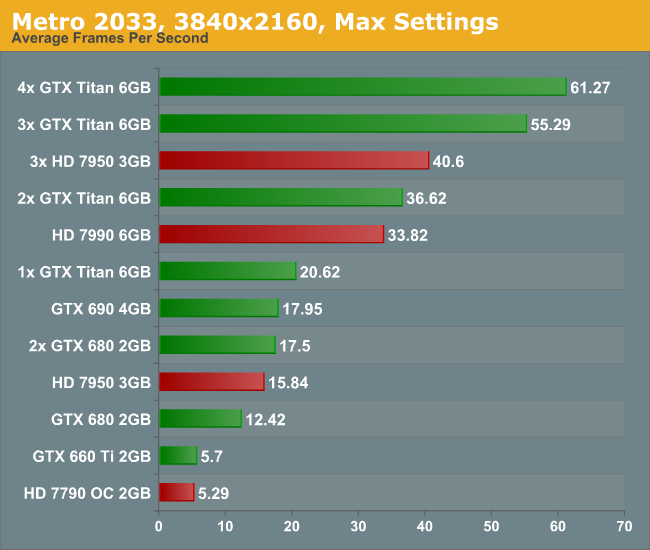
Straight off the bat is a bit of a shocker – to get 60 FPS we need FOUR Titans. Three 7950s performed at 40 FPS, though there was plenty of microstutter visible during the run. For both the low end cards, the 7790 and 660 Ti, the full quality textures did not seem to load properly.
Dirt 3, Max Settings, 3840x2160:
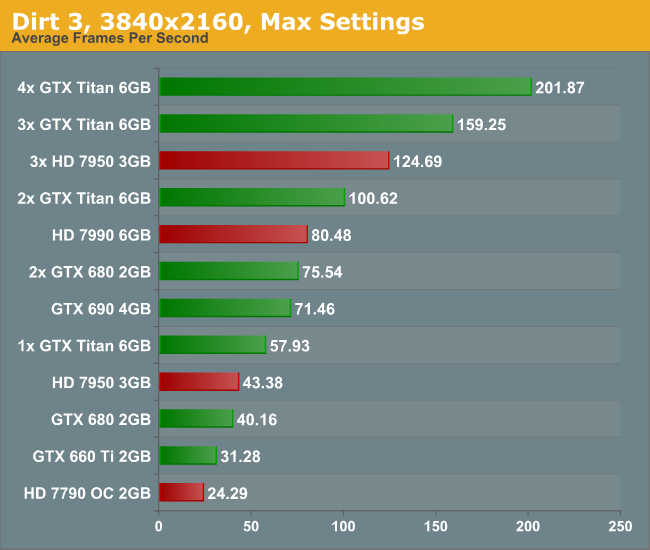
Dirt is a title that loves MHz and GPU power, and due to the engine is quite happy to run around 60 FPS on a single Titan. Understandably this means that for almost every other card you need at least two GPUs to hit this number, more so if you have the opportunity to run 4K in 3D.
Sleeping Dogs, Max Settings, 3840x2160:
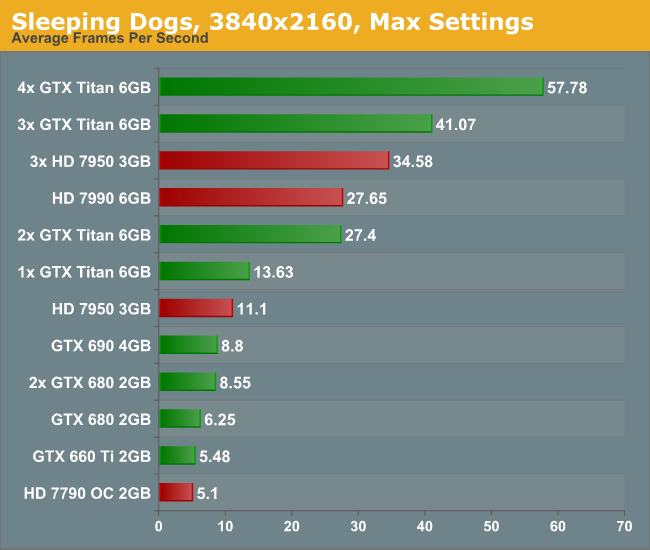
Similarly to Metro, Sleeping Dogs (with full SSAA) can bring graphics cards down to their knees. Interestingly during the benchmark some of the scenes that ran well were counterbalanced by the indoor manor scene which could run slower than 2 FPS on the more mid-range cards. In order to feel a full 60 FPS average with max SSAA, we are looking at a quad-SLI setup with GTX Titans.
Conclusion:
First of all, the minute you experience 4K with appropriate content it is worth a long double take. With a native 4K screen and a decent frame rate, it looks stunning. Although you have to sit further back to take it all in, it is fun to get up close and see just how good the image can be. The only downside with my testing (apart from some of the low frame rates) is when the realisation that you are at 30 Hz kicks in. The visual tearing of Dirt3 during high speed parts was hard to miss.
But the newer the game, and the more elaborate you wish to be with the advanced settings, then 4K is going to require horsepower and plenty of it. Once 4K monitors hit a nice price point for 60 Hz panels (sub $1500), the gamers that like to splash out on their graphics cards will start jumping on the 4K screens. I mention 60 Hz because the 30 Hz panel we were able to test on looked fairly poor in the high FPS Dirt3 scenarios, with clear tearing on the ground as the car raced through the scene. Currently users in North America can get the Seiki 50” 4K30 monitor for around $1500, and they recently announced a 39” 4K30 monitor for around $700. ASUS are releasing their 4K60 31.5” monitor later this year for around $3800 which might bring about the start of the resolution revolution, at least for the high-end prosumer space.
All I want to predict at this point is that driving screen resolutions up will have to cause a sharp increase in graphics card performance, as well as multi-card driver compatibility. No matter the resolution, enthusiasts will want to run their games with all the eye candy, even if it takes three or four GTX Titans to get there. For the rest of us right now on our one or two mid-to-high end GPUs, we might have to wait 2-3 years for the prices of the monitors to come down and the power of mid-range GPUs to go up. These are exciting times, and we have not even touched what might happen in multiplayer. The next question is the console placement – gaming at 4K would be severely restrictive when using the equivalent of a single 7850 on a Jaguar core, even if it does have a high memory bandwidth. Roll on Playstation 5 and Xbox Two (Four?), when 4K TVs in the home might actually be a thing by 2023.
16:9 4K Comparison image from Wikipedia


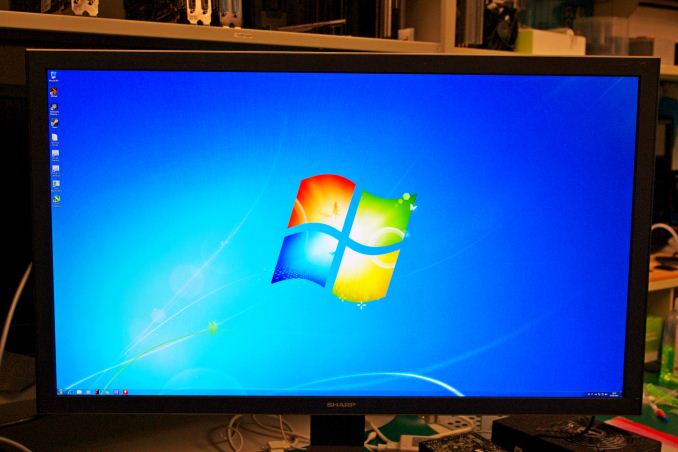

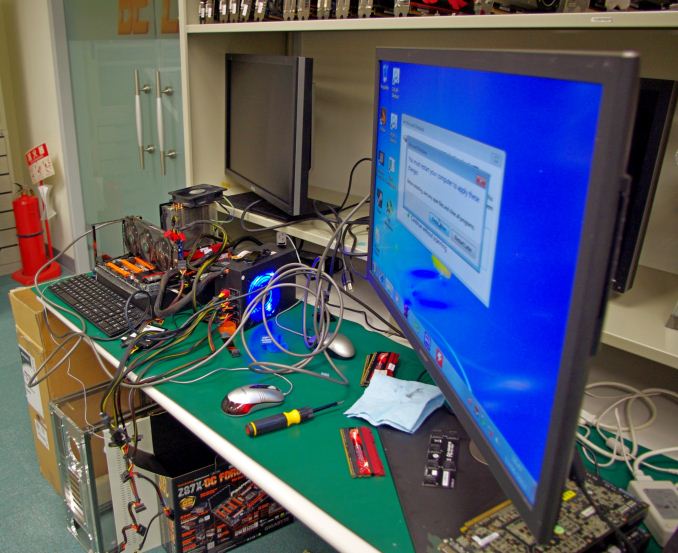

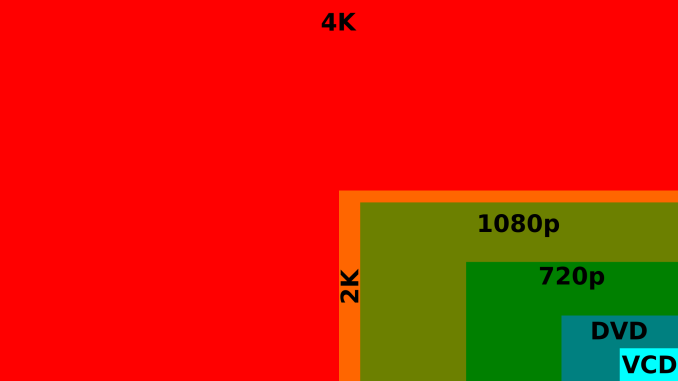








134 Comments
View All Comments
JeBarr - Monday, July 1, 2013 - link
HAHA! good onemulti monitor gamers already know the drill though :D
NLPsajeeth - Monday, July 1, 2013 - link
The ASUS 4K60 monitor will not work with Nvidia cards for the time being. The monitor is being driven by two rx chips via two hdmi cables or a single DisplayPort cable using MST. This means GPUs must support a 2x1 monitor setup to drive the ASUS 4K60. While Eyefinity supports 2x1, Nvidia Surround only supports 1x1 and 3x1 making this monitor useless for gaming.Nvidia has indicated that they will be including such support in R325+ but it still has not appeared yet in the R326 drivers that are available.
Kevin G - Monday, July 1, 2013 - link
Weird. I didn't think it'd have such a handicap but looked it up in the manual. And yes, the Asus display will appear as two 1920 x 2160 displays using DP 1.2 with a 60 Hz refresh rate. This could allow for some funky things like independent rotation, resolution and scaling in windows even though both logical monitors are part of the same physical display.It does appear as one 3840 x 2160 resolution display when the fresh rate is set to 30 Hz over DP 1.2.
jjj - Monday, July 1, 2013 - link
First time Anandtech tests at 4k,you should frame the article.The good thing about GPUs is that 20nm is about to arrive,then the pseudo 16/14nm soon after and if they start to put the RAM on a silicon interposer they gain a lot of memory bw too.
Also the 39inch Seiki is not just announced ,can be pre-ordered at Sears and they list release date as 08/05/13 (fingers crossed for a review and maybe them commenting more on where they are on using 2xHDMI inputs).
IanCutress - Monday, July 1, 2013 - link
After testing, I know I'll want at least a 4K60 for gaming. 4K30 isn't going to cut it, I'd rather have 1080p120 or 1440p60.dishayu - Monday, July 1, 2013 - link
Or 1440p120, perhaps. Which can be achieved with most X-star and QNIX panels, both of which sell for under 300$ shipped. ;)xTRICKYxx - Monday, July 1, 2013 - link
I've been so tempted at buying a cheap korean 1440 panel. But then I realize my GPU will not get good framerates.dishayu - Tuesday, July 2, 2013 - link
I don't really play games much. My HD6770 drives the panel at 100Hz+ and plays my casual games (UT3, Counter strike, dota) just fine. And everything else looks pretty. :Djjj - Monday, July 1, 2013 - link
Yeah ofc ,even if the GPUs most have won't be enough to push 60FPS.But remains to be seen if 4k monitors will be the preferred gaming display , i just want a bigger screen with decent DPI and price for everything and 4k will push prices down but for gaming i do wonder if Oculus Rift and other similar products won't rule the market soon.Even for non gaming glasses could take over ,they can be a few times cheaper than big screens.ludikraut - Monday, July 1, 2013 - link
Having seen a Seiki 4K30 display, I definitely agree that 4K30 isn't going to cut it. It looked awful. For now I'll be waiting for a reasonably priced 55-60" 4K60 (or higher) screen before I replace my existing 1080P display.l8r)